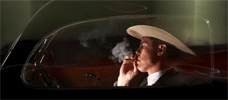Reviews
Jeff Malmberg
USA, 2010
Credits
Review by Victoria Large
Posted on 15 June 2010
Source 35mm print
Categories The 2010 Independent Film Festival Boston
Ask me about my experience at the Independent Film Festival of Boston this year, and it won’t be long before I mention director Jeff Malmberg’s feature debut Marwencol, which was awarded the Special Jury Prize for a documentary feature. A sensitive and compelling story of a most unusual artist, Marwencol is precisely the sort of under-the-radar gem that festival-goers hope to discover.
Marwencol opens with stunning photographs of GI Joes in realistic-looking scenes and poses, underscored by The Pied Pipers singing “Dream (When You’re Feeling Blue),” setting the tone for the undeniably strange, but unexpectedly poignant, journey ahead. Malmberg’s film chronicles several years in the life of Mark Hogancamp, a man who spent nine days in a coma, followed by forty more in the hospital, after being brutally assaulted outside of a bar. Doctors had to rebuild Hogancamp’s face after the incident, and he lost his memory. His mother recalls watching her thirty-eight-year-old son relearning how to walk.
But Marwencol is less about how Hogancamp met physical challenges after the attack than it is about his psychological recovery. Hogancamp had a gift for drawing before the assault, but he’s been unable to regain his ability—his hands shake. In search of some creative outlet he started photographing dolls and models, and built a town in his backyard named Marwencol, a WWII-era Belgian settlement populated by GI Joes and Barbies, many of whom are named for real figures in Hogancamp’s life. (One of them represents Hogancamp himself, and another is Malmberg, complete with a miniature film camera and studio.) Hogancamp explains that Marwencol is governed by a single strict rule: everyone must be friendly to everyone else. Many of Hogancamp’s Marwencol stories trace what happens when visitors to the town - usually dolls in SS uniforms - break the friendliness rule.
Malmberg shapes Hogancamp’s story with an admirably light hand, letting the audience trace the significance of the characters and tenets of Marwencol as they relate to the artist’s own life. The director resists any urge to view Hogancamp with the kind of detached irony that could have sunk this film, but he also refuses to whitewash his subject: the film doesn’t avoid depicting Hogancamp as a troubled man with a tough past; it also acknowledges that Hogancamp is a survivor, a unique talent, and pretty amiable company. Hogancamp gives Malmberg access to a very private world, and the director does not abuse the privilege.
The film openly examines the potential dangers that have come with sharing Hogancamp’s art with the world. After being discovered by a local artist, and having some of his photos published in Esopus magazine, Hogancamp is invited to exhibit his art in New York City. The trouble is this: can one man’s therapy survive under the harsh glare of the New York art world? For that matter, can it survive exposure in this film? These underlying questions push Marwencol from its place as a deeply personal story and into a more universal one. It’s a story about pain, courage, creativity, and places where all of those things meet, and it manages to be honest without being exploitative, and uplifting without getting sentimental. It’s one of those films that pushes me toward the kind of pithy critical raves that I try to avoid. Just see it.
More The 2010 Independent Film Festival Boston
-

The Extra Man
2010 -

Beijing Taxi
2010 -

Taqwacore
2009 -

Cyrus
2010 -

Bass Ackwards
2010 -

Teenage Paparazzo
2010 -

Down Terrace
2009 -

Machotaildrop
2009 -

Colony
2009 -

Erasing David
2009 -

Do It Again
2010 -

Drones
2010 -

His & Hers
2009 -

Looking for Eric
2009 -

How to Fold a Flag
2009 -

Marwencol
2010 -

The Killer Inside Me
2010
We don’t do comments anymore, but you may contact us here or find us on Twitter or Facebook.



